window VOLKSWAGEN GOLF 2008 Owners Manual
[x] Cancel search | Manufacturer: VOLKSWAGEN, Model Year: 2008, Model line: GOLF, Model: VOLKSWAGEN GOLF 2008Pages: 444, PDF Size: 92.7 MB
Page 13 of 444
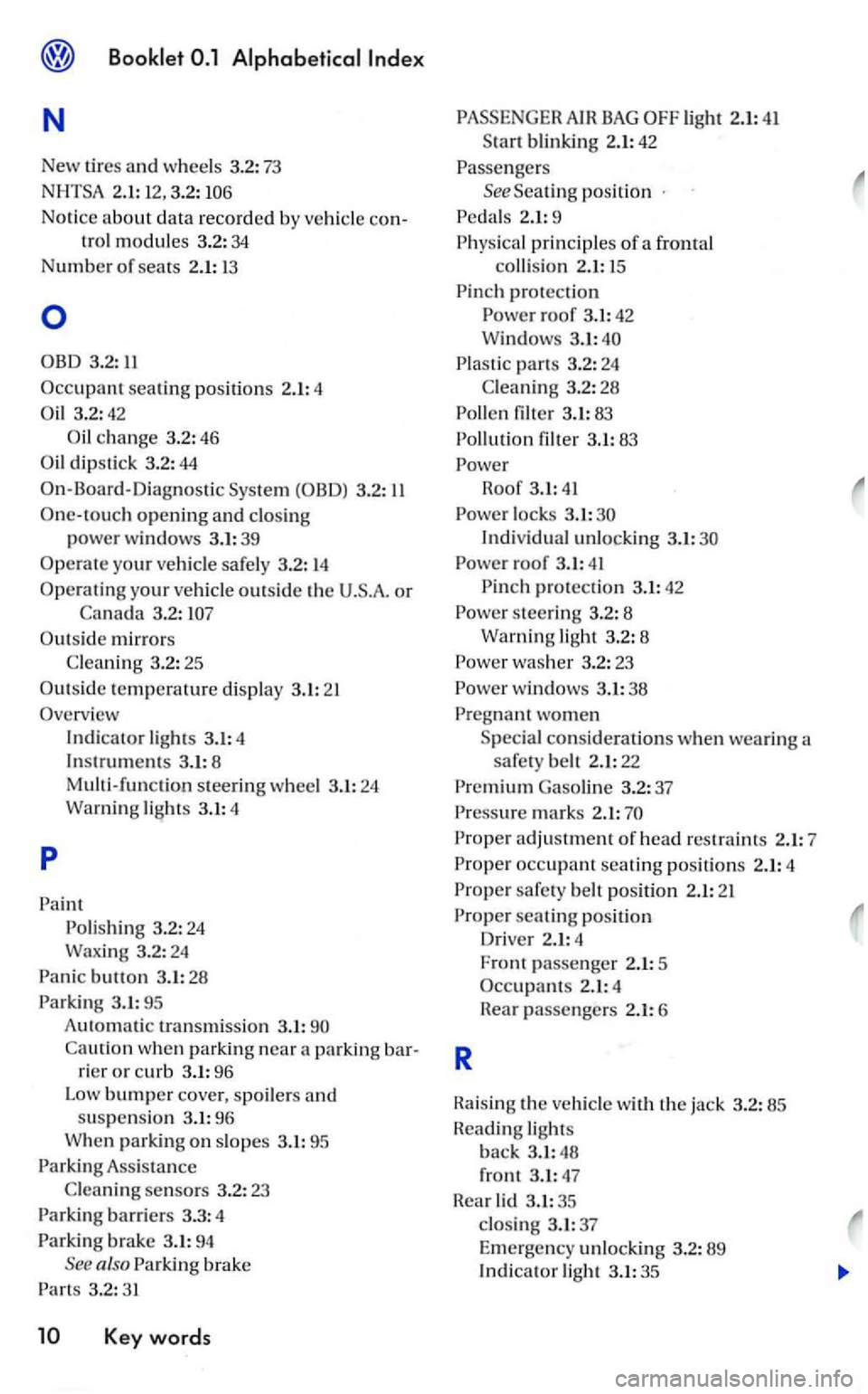
Booklet
N
New tir es and whe els 3.2: 73
tr ol m odules 3.2 : 34
N
umber o f seats 2.1: 1 3
Occ upa nt seatin g posit i o ns 2.1:4
3. 2:4 2
ch a nge 3.2: 46
dip stic k 3.2: 44
On-Boa rd-D iagnosti c (OBD) 3.2:
One-to uch openin g and closing
power
windows 3.1 :39
O p
erate yo ur ve hicle safe ly 3 .2: 14
O perat in g yo
ur veh icle out side th e or
Ca nad a 3 .2:
light s 3.1 : 4
Paint
Polishin g 3.2 : 24 3.2 : 24
Panic button 3.1: 28
Parkin g 3.1: 95
A ut om atic tra nsmi
ssion 3.1:
w hen parkin g ncar a p arkin g rie r or curb 3.1 : 96
L ow bum
per cover, s po ilers and susp en sio n 3.1: 96
also Parking b ra ke
Parts 3.2 : 3 1
K ey w ord s
ligh t 2.1:41
positio n
Ped als 2.1 : 9
P hysica l pr incip les of a f r
ontal
collisio n 2.1: 15
P i
nch pro tect io n
Power roof 3. 1:
42
P lastic parts 3 .2 : 24
C l
eaning 3.2: 28
Pollen filter 3.1:83
P ollu tio n filler 3.1:83
Power
Roof 3.1:4 1
Power locks 3.1 :
In d ividual unlockin g 3 .1 :
P owe r roof 3.1:41
Pinch protect io n 3.1: 42
Powe r s teerin g 3.2: 8
light 3.2 : 8
P o we r was her 3.2:
23
Powe r w ind ows 3.1: 38
Preg na nt wo men
co nside ra tions w hen wearing a
safety bell 2.1: 22
Pre miu m Gaso line 3.2 :37
Pr ess
ure mark s 2.1:
Pro per adju stment o f head res train ts 2.1: 7
P
roper occupant seat i n g positio ns 2.1: 4
Pro per
safe ty bell pos it io n 2.1:2 1
Prope r
posi tion
R
D river 2.1: 4
Fron t passenge r
2.1: 5
Occ upants 2.1:4
Rear passengers 2.
1:6
Rais in g th e ve hicl e w ith th e jack 3.2 : 85
H
eading lig ht s
back 3
.1:48
front 3.1: 47
Rear lid 3 .1 : 35
clos in g 3
.1: 37
Emerge ncy unloc kin g 3.
2:89 Ind icator light 3.1:35
Page 14 of 444
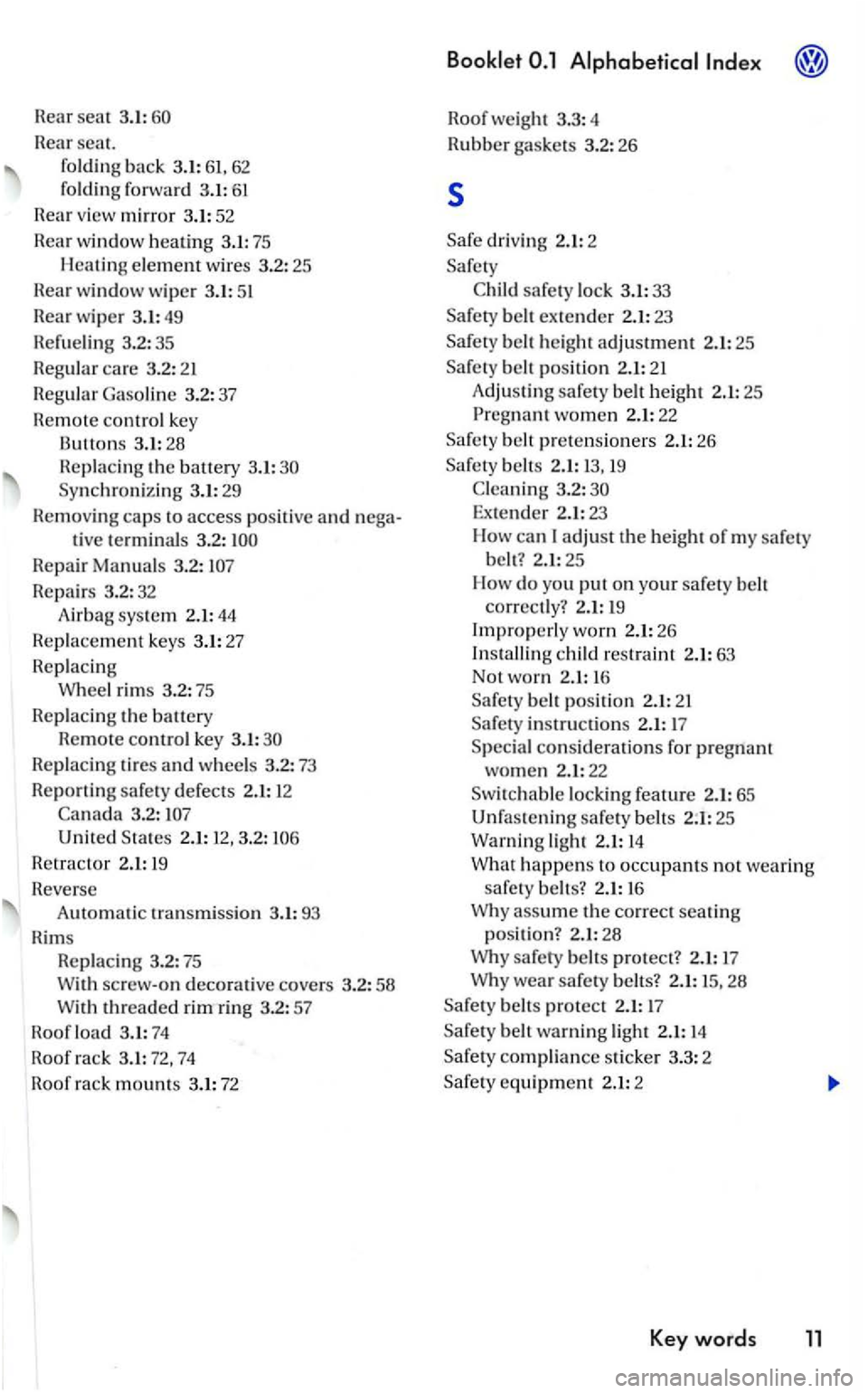
seat 3. 1:
seal.
foldin g back 3.1:61, 62
fold ing forward 3.1: 61
v iew mirror 3.1:52
window heating 3.1: 75
Heating wires 3.2:25
window wiper 3. 1:51
H
earwipe r 3.1:49
3.2: 35
care 3.2:2 1
contro l key tons 3.1: 2 8
Heplaci ng th e bauery 3.1: Synchroni zing 3.1: 29
H emoving caps to acce ss positiv e and tive te rminal s 3.2:
2.1: 12,3.2: 106
R etra ct
or 2.1: 19
R everse
A utomatic transm ission 3.1:93
Hims
R
epl aci ng 3.2: 75 With screw-on decorative cove rs 3.2: 58
With threaded rim ring 3.2:57
Hoof l
oad 3.1: 74
we ight 3.3: 4
Rubb er ga sket s 3.2:
26
s
driv in g 2.1: 2
Sa fety
C hild
safet y lock 3.1: 33
Sa fe ty belt ex te
nder 2.1:23
b elt height adjustment 2.1:25
belt pos ition 2.1:21
Adju sting safe ty
belt height 2.1:25
Pr eg nant
women 2.1: 22
Sa fe ty belt pre tension ers 2.1:26
Sa fety belt s
2.1: 13, 19
C leaning 3.2:
Extende r 2. 1: 23
Ho w ca n I adjust the height of my safety
belt? 2.1: 25
How
do yo u pu t on your safety belt correc tly? 2.1 : 19
Improp erly worn 2.1:26
child restraint 2.1:63
N ot
worn 2.1: 16
belt positi on 2.1: 2 1
instru ction s 2.1: 17
S p ec ial c
onsiderations for pregnant women 2.1: 22
Swi tc h able lo cking feature 2.1: 6 5
Unfa ste
ning s afety be lt s 2.1:2 5
Warning lig ht 2.1: 14
What happens to occ upants not wearing
safe ty be lts? 2.1: 16
Why assume
the correct seatin g
po sition ? 2.1:28
Why saf e ty belt s protect ? 2. 1: 1 7
Why wear safety belt
s? 2.1: 15, 28
Safe ty belts pro tect 2.1: 17
b elt warning ligh t 2.1: 14
Safety compliance sticke r 3.3: 2
Key words 11
Page 15 of 444
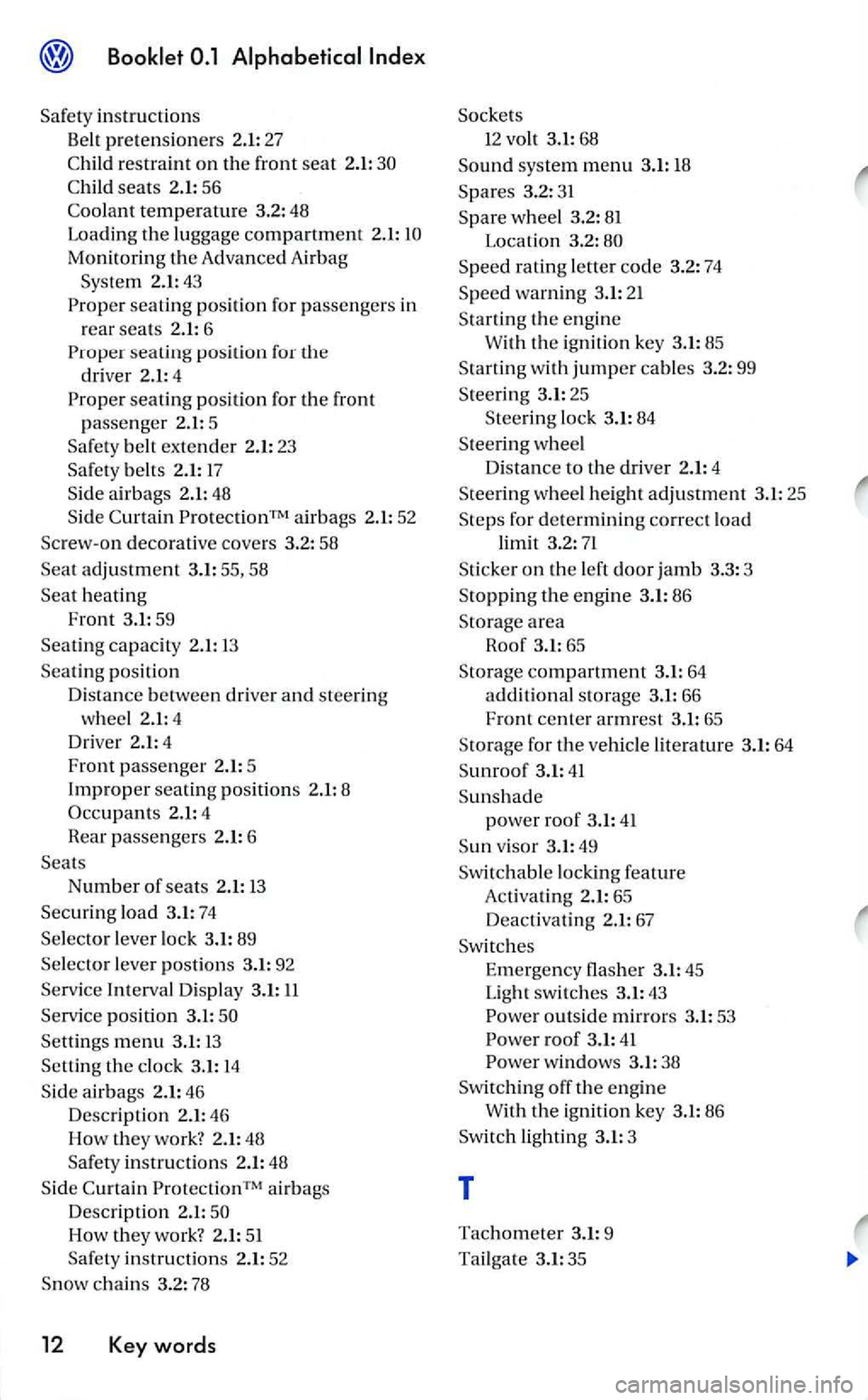
Safety instructions
Belt pretensioners 2.1: 27
Child restraint on the front seat 2.1:
Child seats 2.1 : 56
Coolant tempera ture 3.2:48
Loading
the lu ggage compartment 2.1:
seating position for passengers in
r
ear seat s 2.1: 6 seating position for
driver 2.1: 4
seating position for the front
passenger 2.1: 5
Safety belt extender 2.1: 23
Sa fet y
belts 2.1: 17 S id e airbag s 2.1: 48
Side Curtain ProtectionTM airbags 2.1: 52
Screw-on decorati ve covers 3.2: 58
Seat adjustment 3.1: 55, 58
Seat heating
Front 3.1:
59
Seating ca pacity 2.1: 13
Sea ting
position
Di s
tance between driver and ste erin g
w
hee l 2.1:4 Dr iver 2.1: 4
Fron t passen ger 2.1: 5 Improper seatin g position s 2.1: 8
Speed rating le tter code 3.2: 74
Speed warning 3.1: 21
Starting th e engine W ith the ig nition key 3.1:85
S tartin g
with jumper cables 3.2: 99
Stee rin g 3.1: 25
S
teering lock 3.1: 84
S te ering
wheel
Di s
tance to the driver 2.1: 4
Steerin g wheel height adjustment 3.1: 25
S
teps for determining co rrect load limit 3.2: 71
Sticker on th e left door jamb 3.3 : 3
Stopping the en gine 3.1:8 6
Sto rage
area
Roof 3.1:65
S torage
compartment 3.1: 64
additional sto rage 3.1: 66
Front center armrest 3.1: 65
S torage for
the vehicle literature 3.1: 64
Sunroof 3.1: 41
Sunshade
power roof 3.1:41
Sun viso r 3.1:49
Sw itch
able loc king feature
Activatin g 2.1: 65
D
eacti va tin g 2.1: 67
Sw itches Em ergency flasher 3.1: 45
Light swit ches 3.1: 43 outside mirrors 3.1: 53 ro of 3.1:41 windows 3.1: 38
Sw itching off the engin e
W ith the ignit ion key 3.1: 86
Sw itch
lig htin g 3.1: 3
T
Tachometer 3.1: 9
Ta
ilga te 3.1:35
Page 91 of 444
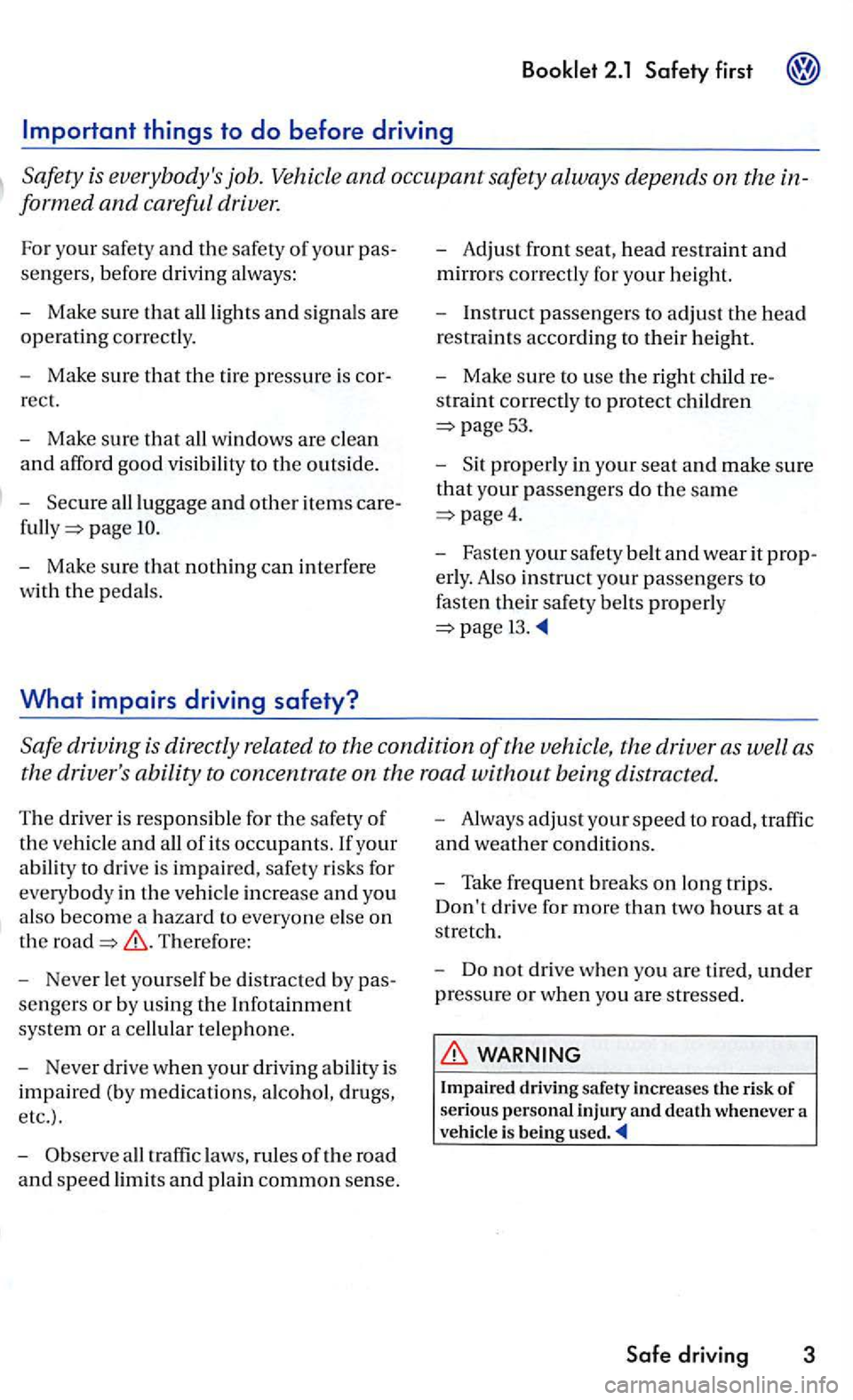
driver.
For your safety and the safety of your pas
sengers, before driving always:
- Make sure
that all lights and signals are
operating corr ect ly.
- Make su re
that the tire pres sure is cor
r
ect.
- Make sure that all windows are clean
and afford good visibility to the outside .
- Secure all luggage and
other items care
page
re
stra int correctly to protect children
53.
- S it properly in your seat and make sure
that your passengers do the same
4.
- Fasten your safety belt and wear it prop
erly. Also instruct your passenge rs to
fasten their safety belts properly
Safe driving is directly related to the condition of the vehicle, the driver as well as
the driver' s ability to concentra te on the road without being distracted.
The driver is responsible for the safety of
the vehi cle and all of its occupants. If your
ability to drive is impa ir ed, safety risks for
everybody in
the vehicle in crease and you
a lso becom e a hazard to everyo ne else
on
the There fo re:
- Never let yourse lf be di stracted by pas
sengers
or by using the Infotainm ent
syste m or a cellular tel ephone.
- Never drive w
hen your driving ability is
impa ired (by medication s, alco hol,
drugs,
etc.) .
- Observe a
ll traffic laws, rules of th e road
and speed limit s and plain common sense. -
Alway s
adjust you r speed to road, traffic
a
nd weathe r conditions.
- Take frequen t breaks on long trip
s.
Don't drive for more than two hours at a
s tretch.
-
Do n ot drive when you are tir ed, unde r
pressure
or when you are stresse d.
WARNING
Impaired driving safety increases the risk of serious personal injury and death whenever a
vehicle is being used
Page 94 of 444
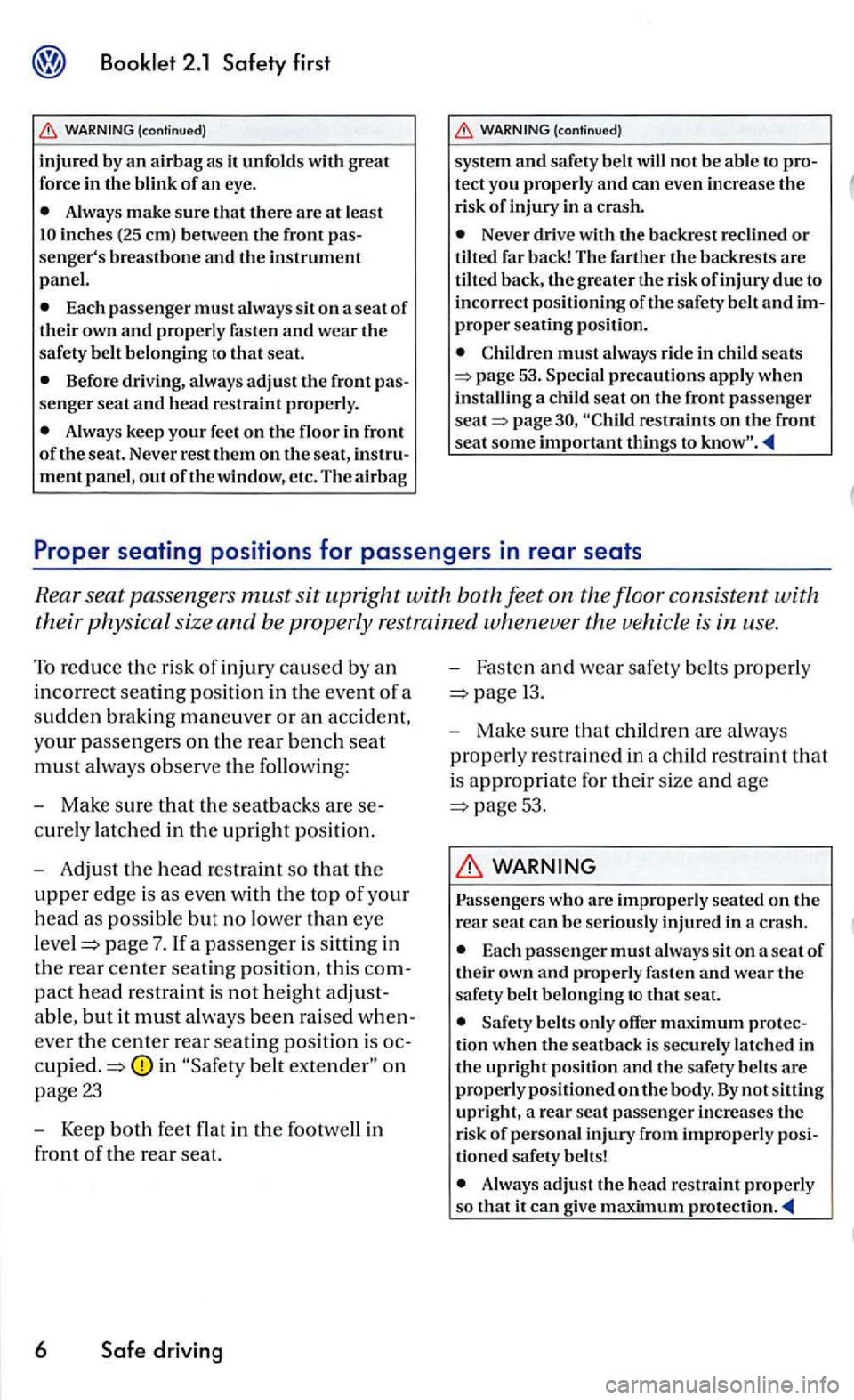
Always make sure that there are at least
Each passenger must always sit on a seat of their own and properly fasten and wear the safety belt be longing to that seat.
Before driving , always adjust the front senger seat and head re straint properly.
Alway s keep your feet on the floor in front of the seat. Never rest them on the seat, ment panel, out of the window, etc. The airbag
tect you properly and can even increa se th e
risk of injury in a crash.
Neve r drive with the backre st recl ined or tilted far back! The farth er the b ackrests are
tilted back, the greater the risk ofinjury due to
in correct positioning of the safety belt and
must always ride in seats 53. a child seat on the front passenger page
Mak e sure that the seatback s are
curel y lat ch ed in the upright position.
A djust th e head restraint so that the
upper edge is as even with the top of your
head as possible but no lower than eye
pag e 7. If a passe nger is s ittin g in
the rear center seating pos ition, this
pac t h ead restra int is not h eight
a ble , but it must always bee n rais ed
eve r the center rear seating posit ion is
belt on
page 23
Keep both feet flat in the footwell in
front
of the rear seat.
6 Safe driving
Fasten and wear safe ty belt s properly
13.
Make sure that children are always
prop e
rly restra in ed in a child re str aint that
is appropriate for thei r size and age
5 3 .
WARNING
Pas sengers who are improperly seated on the rear seat can be se riou sly injure d in a crash.
Each passen ge r must always sit on a seat of th eir own and properly fasten and wear the safety belt belonging to that seat.
belt s only offer maximum tion when the seat back is securely latched in
th e upright po siti on and the safety belts are
properly positioned on the body. By not sitting
upright , a re ar seat pass enger increases the risk of personal injury from improperl y
Always adjust the head restraint properly so that it can give maximum
Page 99 of 444
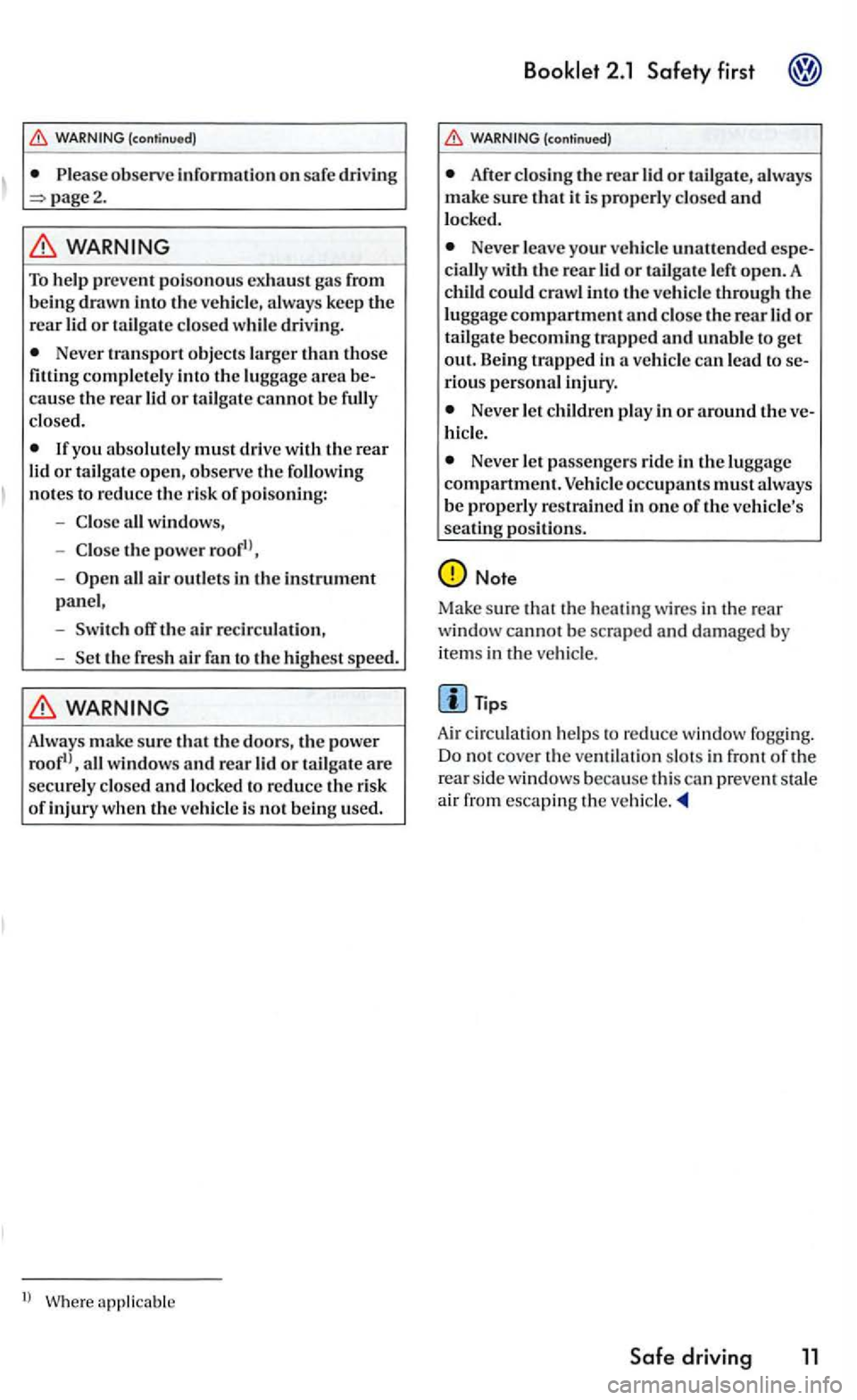
(continuod)
page2.
To hel p prevent p oisonous exhaust ga s from
b eing drawn into the ve hicle , a lways keep the
rear lid or t ailgat e closed w hil e driving.
Neve r transport o bjects la rger than those fitting comple tel y into th e luggage are a cause the rear lid or tailgate canno t b e full y
closed .
yo u absolute ly mus t drive with the rear
lid or t a ilgate ope n, o bserve the foll owing
n otes to reduce the r is k poisoning :
C lose w indows,
C lose th e power
air outl ets in the instrument p a n el,
off the air recirc ulation ,
Always make sure that the doors, the po w er
W here
Booklet 2.1 Safety first
Af te r closin g the rear lid o r tailgate, always make sur e tha t it is properl y closed an d locked.
Never leave your vehicle unattended
ri ous pe rson al injury.
Neve r let childre n play in o r around the hicl e.
Neve r let passengers ride in the luggage compartment. Vehicl e occupants must always
b e properl y res traine d in one of the ve hicle's seatin g position s.
Note
Make su re that the heating wires in the rea r
w indow cannot be scraped and damaged b y
ite ms in the ve hicle .
Air ci rc ulation he lp s to reduce wi ndow fogging. Do not cove r the ventilation slot s in front o f the rea r si de windows beca use this can prev ent sta le
a ir from escaping the
Safe driving 11
Page 106 of 444
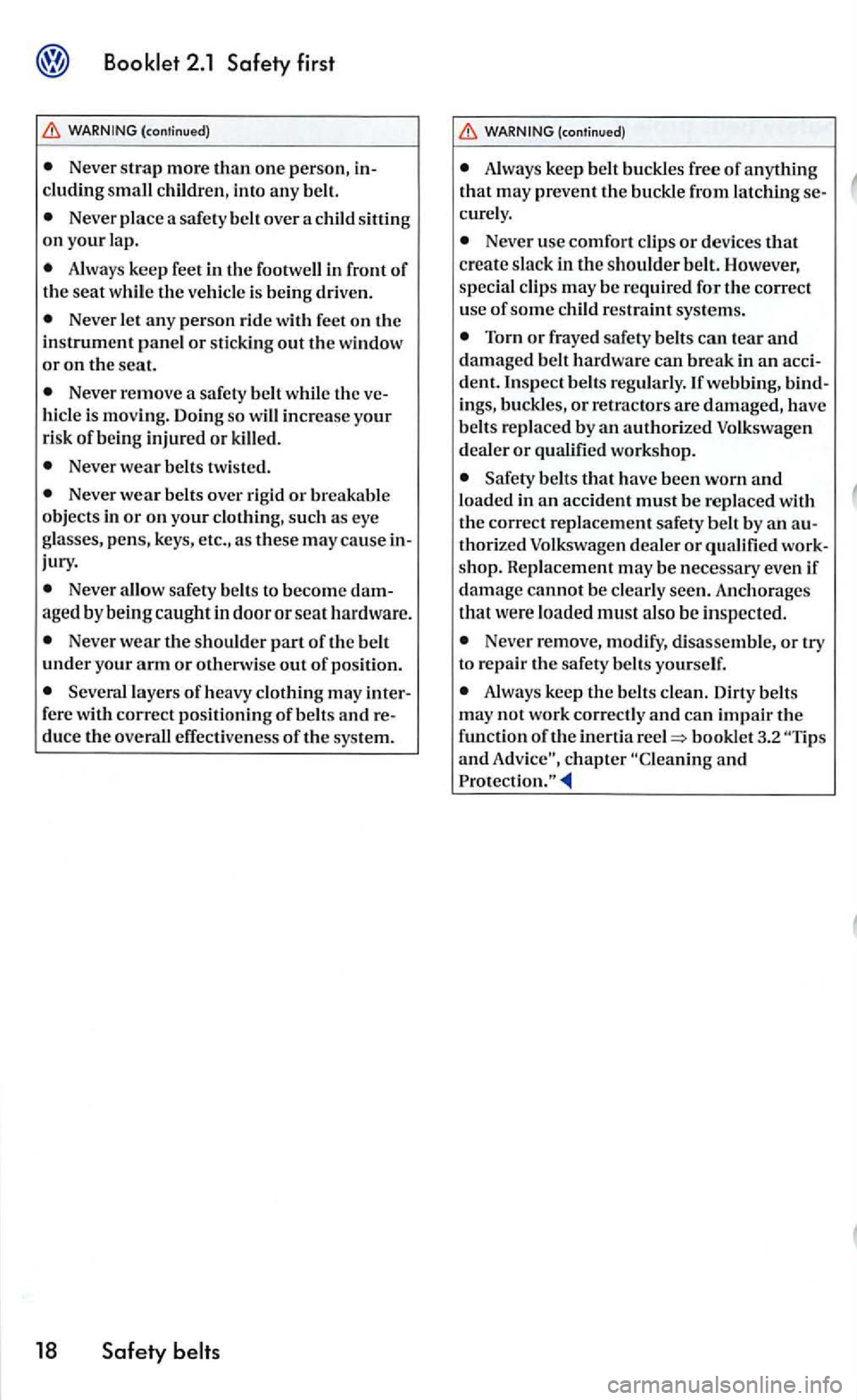
2.1 Safety first
Never strap more than one person, in
cluding c hildren, into any belt.
Never place a safety belt over a child sittin g on your lap.
• Always keep feet in
the footwell in front of the seat while the vehicle is being driven.
Never let any person ride with feet on the instrument panel or sticking out the window or on the seat.
Never remove a safety belt while the ve
hicle is moving. Doing so will increase your
risk of being injured or killed.
Never wear belt s twisted.
Never wear belt s over rigid or breakable
objects in or on your clothing, such as eye
glasses, pens, keys, etc., as these may cause injury.
Never allow safety belts to become damaged by being caught in door or seat hardware.
Never wear the shoulder part of the belt under your arm or othenvise out of position.
Several layers of heavy clothing may inter
fere with correc t positioni11g of belts and reduce the overall effectiveness of the sys tem.
18 Safety
(continu ed)
Always keep belt buckles free of anything
that may preven t the buckle from latch ing se
cure ly.
Neve r use comfort clips or devices that create slack in the sh oulder belt. However,
specia l clips may be required for the correct
use of some c hild restraint systems.
Torn or frayed safety belts can tear and damaged belt hardware can break in an accident.lnspect belts regularly. If webbing, bind
ings, buckles, or retractors are damaged, have
be lts replaced by an authorized Volkswagen
dealer or qualified workshop.
Safety belts that have been worn and loaded in an accident must be replaced with the correc t rep lacement safety belt by an authorized Volkswagen dealer or qualified work
s h op. Replacement may be necessary even if damage cannot be clearly seen. Anchorag es
that were loaded must a lso be inspected.
Never remove, modify, disassem ble, or try
to repair the safety belts yourself.
Alwa ys keep the belts clean. Dirty belts
may not work correct ly and can impair t11e func tion of inertia reel booklet 3.2 and
Page 137 of 444
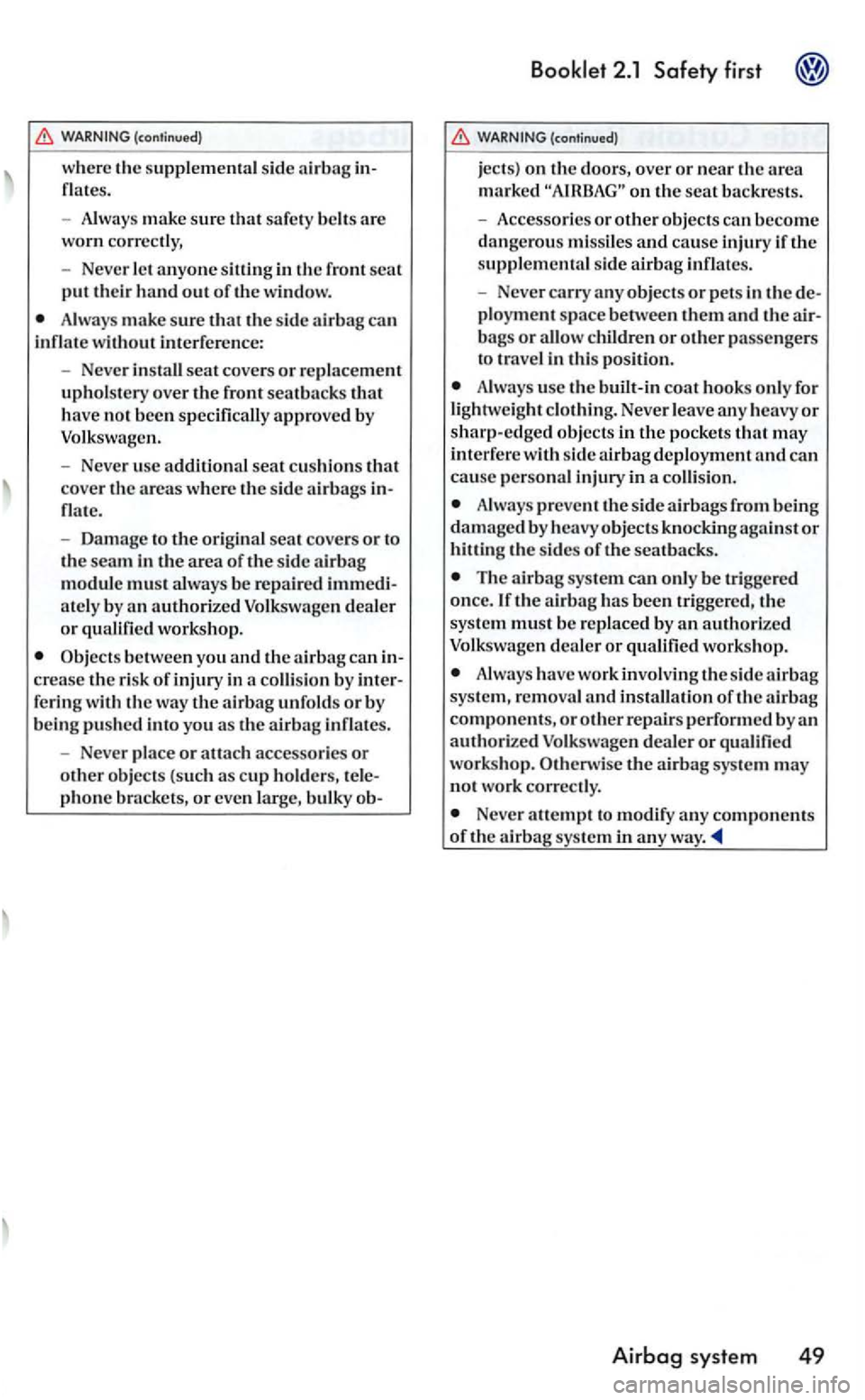
flates.
- Alway s
make sure that safety belts are wor n correctly,
- Never le t a nyo ne s itting in the front
seat put th e ir hand o ut of the window.
Always make sure th at the sid e airbag can
inflat e without interferen ce:
- Neve r in stall se
at covers or re p lace ment upholstery over th e front seat back s that
h ave not bee n specifica lly approved by
- Never use additional seat cushi on s that co ver th e areas where th e s ide airbag s flate.
-
Dam age to the original seat covers or to
th e seam in th e area of th e si de airbag
modul e must alwa ys be repaired ate ly by an authorized
betwee n yo u and the airbag can crease th e risk of inju ry in colli sion by fering with the way the airb ag unfold s or by bei ng pushed you as th e a irba g infl ates.
- Neve r pla ce or a
ttach accesso ries or other objec ts (su ch as cup hold ers , phone brac ke ts, or eve n bulky ob-
(continued)
jec ts) on the doors , over or n ear th e area marke d on the seat ba ckre sts.
- Acc esso ries or other objects ca n beco me
dangerou s mi ssiles and cause inju ry
ploy ment space between them and the bags or allo w children or other passengers
to travel in thi s po sition.
Always usc the built-in coat hook s only for ligh tweig ht clothing . Never leave any h eavy or sharp-ed ged obj ec ts in the po cke ts that may
int erfe re w ith side ai rba gdeployment and can cause personal injury in a collisio n.
Always prevent the sid e airbags from being damaged by heavy object s knockin g or hitting the sides of the seat backs.
The ai rb ag syste m can onl y be tri gge re d
once. the airbag has bee n tri ggered, the sys tem mus t b e re placed by an authori zed Volkswagen dealer or qualifi ed work shop.
Always have work invo lv in g th e s ide airbag
syste m, re m ova l a nd installa tion of th e airbag
components, orothcrrep air s p erformed by an authorized Volkswagen dealer or qualified works ho p. Otherwise th e a irbag sys te m may
n ot work correctly.
Neve r attempt to modify any com ponents of the airbag syste m in any wa y
Airbag system 49
Page 138 of 444
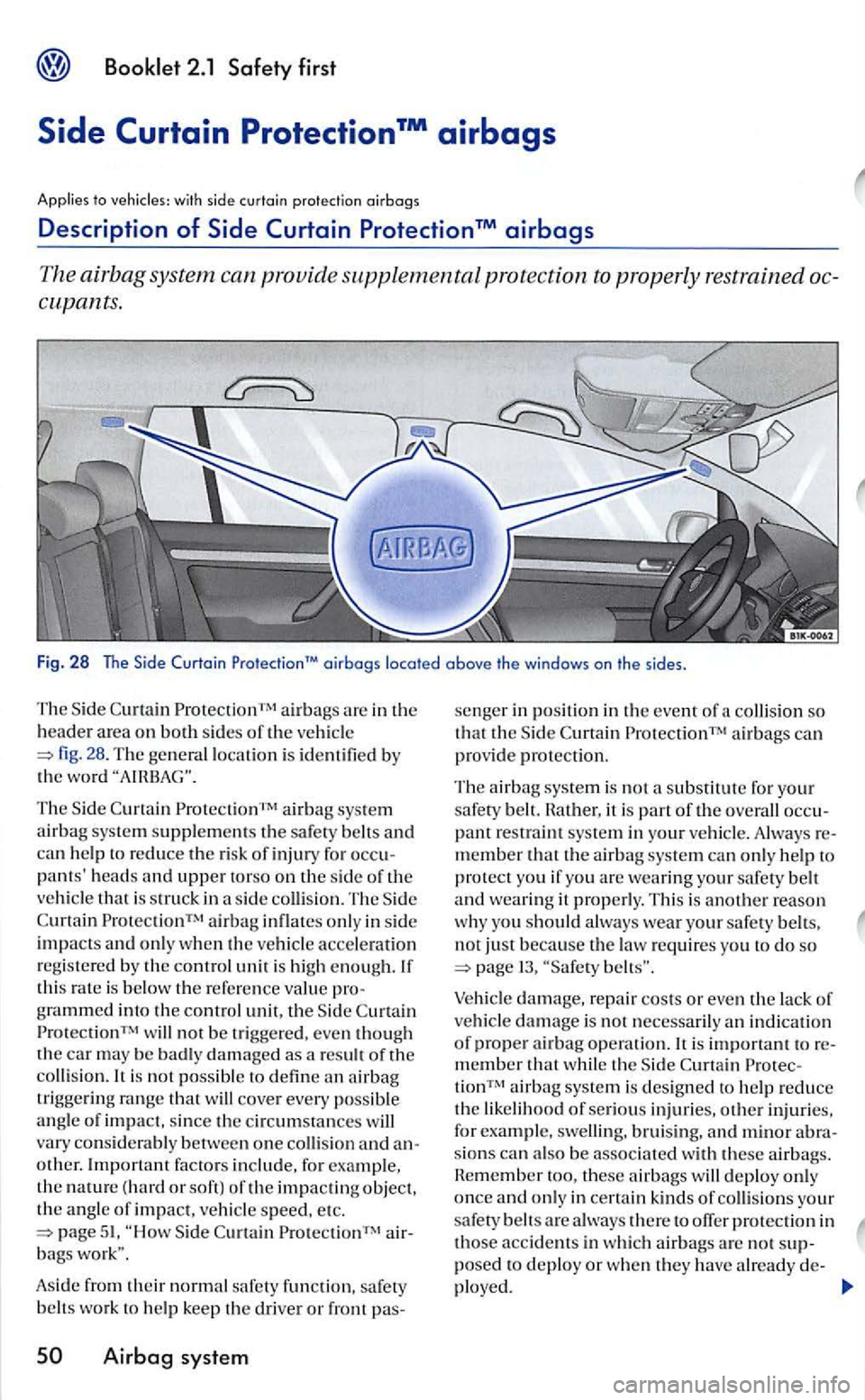
with s ide curtain protection oirbogs
Description of
oirbogs located above th e windows on the sides .
T he Side
28 . The general locatio n is identified by the wo rd
T he Side airbag sys tem airbag syste m su ppl em ent s the safety belts and can help to reduce the ris k of injury for heads a n d upper to rso on the side of the th at i s s truck in a side collis io n. Th e S ide
gramm ed into the control unit, the Side w ill not be triggered. even thou g h the car may be badly d am aged as a res ult of the collision.
ot her. Import ant fac tors of the impacting object, the angle of impact, ve hicle speed, etc.
bags
Aside fro m their normal safe ty fun ctio n, sa fety belt s work to help keep th e driver or front pas-
pant restraint syste m in you r ve hicle. Always member that the airbag system can o nl y help
yo u should always wear your safety belt s, not just because the law requires you to do so page
Vehicle damage, repair costs o r even the lack of
ve hicl e damage is no t necessarily an indicati on of proper a irbag operation. It is important member t hat while th e Side
kinds of collis ions your sa fet y belt s are always there offer protect ion in those accid ents in which airbags are not sup-posed deploy or when they have already de-ployed.
Page 139 of 444
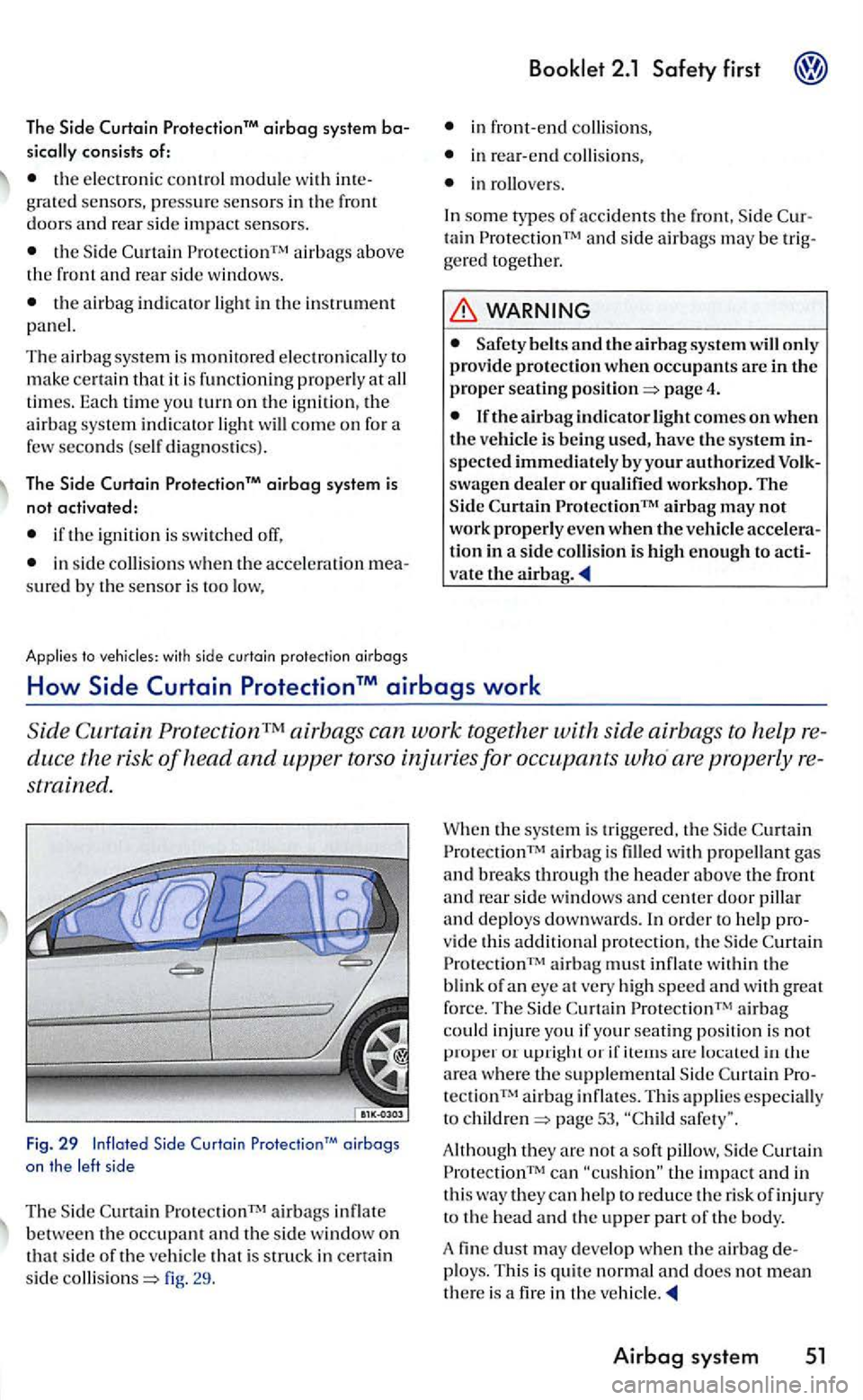
The Protection'M airbag system
consists of:
the elec troni c control module with grated senso rs, press ure sensors in the doors and rear side impact sensors.
airbags above the front and rear side w indo ws.
the ai rbag
Protection airbag sys te m is not activated:
if the ignit ion is sw itched off,
in sid e collisio ns w he n the acceleratio n sured by the senso r i s too low,
Applies t o vehi cles: w ith side curta in protection oirbogs
Booklet 2.1 Safety first
in front-end collisio ns,
in rear-end collision s,
some types of accidents the fron t, Sid e tain ProtectionTM side airbag s m ay be
Safety belts and the airhag syste m will only
provide protection w hen occupants are in the proper seating page 4.
spected immedia tel y by you r authori ze d
tion in a side co llision is hig h enough to vate the .
How
duce the risk of head and uppe r torso injuries for occupants are properly
strained .
Fig. 29 airbogs on th e left sid e
Th e Sid e airbag s infl ate
b etween the occupant a nd the si de window on
that sid e of th e ve hicl e is struck in certain
s ide fig . 29 . When
the sys
te m is tri gg ered, the Sid e airba g is fille d with propellant gas
and break s th roug h th e header above the front and rear sid e window s and center d oo r pillar and deploys dow nwards. In order to help v ide thi s additional prote ction, the S ide ProtectionTM airba g must inflate w ith in th e
b lin k of a n eye at very high speed and with great force. The Sid e Protectio nTM airba g
co uld injure you if your seating posit io n is not proper o r upright or if area where tec tion TM a irbag in fla tes. T hi s appli es especially
t o page 53,
the impact and in
th is way they can help to reduce the risk o f injury
t o th e head and the upper part o f the bo dy.
A fin e dust m ay deve lo p w hen th e a ir b ag ploys. This is quite norm al and does n ot mean
th ere is a fir e in th e ve hicl e .
Airbag sy ste m 51